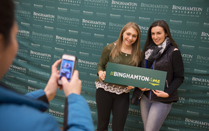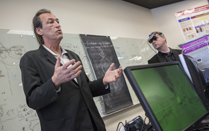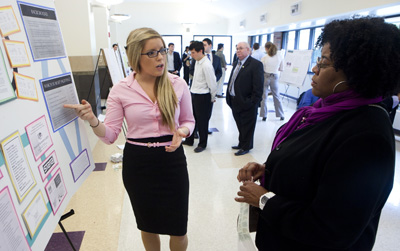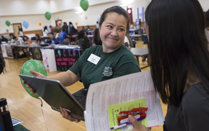Binghamton University President Harvey Stenger's Quarterly Report - March 31, 2015
With Binghamton’s long winter slowly giving way to spring, I know that our entire campus community is looking forward to the respite that Spring Break brings. We all need an opportunity to rejuvenate and recharge our batteries as we push into the final weeks of the semester. It has been an exciting and successful quarter highlighted by new faces and new academic programs and a touch of Hollywood-style glamour. At the same time, the University continues to work on a number of campus and community challenges that will require the involvement and commitment of the entire campus community.
In fact, one of the things that most impresses me about the University is its dedication to addressing real-world challenges — from the economic and social environment of the Southern Tier and beyond, to the academic and cultural challenges faced by our students. Our Road Map commits us to increasing our impact, “from the local to the global level,” and it is remarkable to see how our campus community responds to this demand. This quarter alone, we have heard from an alumnus, Skip Rizzo, PhD ’91, who is using virtual reality to overcome post-traumatic stress disorder; seen electrical and chemical engineering researcher Seokheun “Sean” Choi develop cutting-edge bio-solar cells that produce power from bacteria; and learned that Geological Sciences and Environmental Studies graduate student Jason Johnson is working to protect water quality in the Susquehanna River basin — and these are just a few of the many ways that Binghamton students, faculty, and staff are working to transform our communities.
Engaging on campus, in the community and across the globe
Binghamton’s commitment to engaged teaching, research, and scholarship was highlighted during a recent conference hosted by our Center for Civic Engagement. Conference attendees included representatives from throughout SUNY, as well as leaders from Campus Compact, an national coalition of colleges and universities committed to campus-based civic engagement. It was a successful meeting that included presentations from national service-learning experts and emphasized the innovative student projects, faculty research, and service that is conducted by University students and faculty.
In March, students hosted the fifth annual TEdXBinghamtonUniversity conference, bringing seven speakers to the Anderson Center stage, including two Binghamton alumni and, for the first time, an undergraduate speaker, mathematics and computer science major Jack Fischer. CNN legal analyst Sunny Hostin ’90 discussed the points in life that change personal directions, while Dubai Mercantile Exchange CEO Christopher Fix ’86 addressed the personal challenges of succeeding in a global industry. Other speakers included Adam Eskin, CEO of a New York City restaurant chain; Maria Santelli, an advocate for conscientious objection; hula-hoop artist Lisa Lottie; and Zephyr Teachout, law professor and former candidate for New York state governor. TedX and other colloquia, symposia and lectures are all aspects of the University’s efforts to address significant challenges across a range of issues. Developing more opportunities for the campus community to hear from scholars, researchers and public intellectuals is an important part of our Road Map efforts to increase our impact.
The community also had an opportunity to participate in the premier showing of “The Rewrite,” the recent film produced by Binghamton alumnus Marc Lawrence ’81, which showcased the University and the Binghamton community. It was a very fun event, during which more than 1,200 people attended the showing and met with Lawrence and lead actor Hugh Grant, as well as three supporting actors. This movie, which places Binghamton in a very positive light, is a special opportunity for the University, as it will reach millions of potential viewers and help raise our campus profile. I’m grateful to Mr. Lawrence for his generosity and support for the University.
Moving from the local to the global level, the University has taken several steps recently to maintain and increase its worldwide impact. Current Vice Provost for International Affairs Katharine Krebs has announced that she will be stepping down from the position in May; Provost and Executive Vice President for Academic Affairs Donald Nieman and I have appointed Dean of the Watson School and Director of the Watson Institute for Systems Excellence (WISE) Krishnaswami “Hari” Srihari to succeed Krebs upon her retirement. Srihari has demonstrated a keen grasp of the challenges and opportunities that the University faces in the area of international education, and has been very successful in developing new international partnerships that have strengthened both the Watson School and the entire University. He has received international recognition for his internationalization work and was recently honored by the Association of Public and Land-grant Universities (APLU) with its highest award for international leadership. He will continue in his current role as dean.
The internationalization of Binghamton’s academic and research programs is also being strengthened through the addition of a new Center for Israel Studies that will offer research, study-abroad and learning opportunities for graduate and undergraduate students as well as faculty members beginning in the 2015-16 academic year. Associate Professor Randy Friedman will serve as director of the center. Funding provided through a multi-year grant from the Washington, D.C.-based Israel Institute will allow for the hiring of three additional faculty who will work closely with our internationally recognized Middle Eastern and North African Program (MENA). This is a unique opportunity for the campus and its students, many of whom have expressed an interest in a broader Israel studies program.
Engagement with the community also requires that the University be a diverse and inclusive space. During the last quarter, I, along with other senior campus administrators, have held a number of conversations with the student group Students for Change. This organization has made demands of the University focusing on concerns about harassment and discrimination. The group’s broad goal is an important priority to me — to make Binghamton University an inclusive community that respects and values everyone. I strongly believe that Binghamton University has been working diligently on these issues, and has made progress toward greater inclusiveness, diversity and educational access. Still, I believe that there is more we can and will do to further the diversity of our faculty, staff and students; to improve the inclusiveness of our campus environment and improve how we interact with each other. This is why, two years ago, I chose to make diversity, equity and inclusion one of our five strategic priorities, and created the Office of Diversity, Equity and Inclusion to help the campus find ways to address these challenges. It is important that these conversations continue in a manner that is respectful, so that Binghamton will continue to be recognized as a thriving academic community where all persons feel valued and welcome.
Because of our willingness to engage with students, with the community and with the globe, Binghamton has gained a strong reputation for academic excellence and engaged research. In just the past few weeks, we have been recognized as the “top four-year college” in New York by the Albany Business Review, and Time magazine ranked Binghamton ninth among all four-year public colleges in the United States (out of more than 160) on its list of “Public Colleges Where Students Graduate the Fastest.” This last ranking is especially important in this era of high student debt, as it means that students graduate from Binghamton in a timely manner and move quickly into their careers, saving thousands of dollars in tuition costs and student loans — while reducing the tax burden for New York state residents.
New people: Admissions, faculty and campus leadership
The months from January to March are a key part of the academic cycle, as this is the time when we make many of our preparations for the next academic year — admitting new students, hiring new faculty and ensuring that campus services are in place.
This year saw the University receive a record number of applications for undergraduate admission. For the first time, freshman applications topped 30,000, suggesting that the 2015 incoming class will be the most selective ever. Because last year more students selected Binghamton than we anticipated, we have decided to slightly decrease the target class size to 2,500 compared to 2,650 in 2014. This will allow us to remain within the enrollment goals developed as part of our NYSUNY 2020 plan. At the same time, graduate applications and admissions are up slightly, reflecting the University’s growing reputation for advanced research and scholarship.
One of the factors allowing us to increase enrollment has been the significant surge in faculty hiring that has occurred as a result of the NYSUNY 2020 plan. Over the past three years, we’ve hired 190 new faculty, increasing our total faculty by 90. This growth in faculty numbers will enable us to increase our reputation for outstanding research and scholarship while helping us to reduce our student-to-faculty ratio.
This year our hiring is spread out across the University: 39 positions in Harpur, 14 in Watson, six in SOM, four in CCPA, four in Decker and three in pharmacy. Within Harpur, they are spread pretty evenly across the fine arts and humanities, social sciences and math/science. We are meeting the needs of the entire campus with our hiring plan. Equally important, these new faculty members include both experienced and successful researchers and scholars as well as individuals who are new to their disciplines, and they are pushing discovery in exciting new directions.
For example, the Department of Psychology has hired one of the best-known addiction researchers in the world, formerly a senior professor at UCLA, as part of its NIH-funded Developmental Exposure Alcohol Research Center. Similarly, the College of Community and Public Affairs’ Department of Social Work has hired two outstanding assistant professors with degrees from the University of Chicago and Columbia, two of the top programs in the country. One studies community based models of disease prevention while the other does research on the social and community factors affecting the success of individuals who make the transition from prison to families and communities.
With assurances of funding for our new for our new School of Pharmacy and Pharmaceutical Sciences provided in both the legislature’s and governor’s budgets, we are moving forward on hiring of key school leaders. In January, we announced the appointment of the school’s founding dean, Gloria E. Meredith, former dean of the College of Pharmacy and professor of pharmaceutical sciences at Rosalind Franklin University of Medicine and Science in North Chicago. Meredith also served as founding dean at Rosalind Franklin, so she comes to Binghamton with a great deal of relevant experience. Already, she has hired an assistant dean for operations and finance, and is organizing the necessary searches for associate dean and chairs for the departments of pharmaceutical sciences, pharmacy practice and health outcomes. When on board, these individuals will constitute the leadership team that is necessary to develop the curriculum, and will prepare the application materials for the accrediting body, the Accrediting Council for Pharmacy Education (ACPE). We hope to have these positions filled by this summer.
One critical office that has been filled this quarter is that of our Educational Opportunity Program director. Binghamton alumnus Calvin Gantt ’92 comes to Binghamton from Geneseo, where he served as director of their Access Opportunity Programs (AOP) since 2007. A recipient of the SUNY Chancellor’s Award for Excellence in Professional Service in 2012, Gantt has large shoes to fill as director of EOP, but I am confident that his experience and commitment to Binghamton’s students will serve him and the campus well.
We also are very close to hiring a new dean of libraries. Candidates were on campus over the past several weeks, and we hope to have an announcement shortly after this report is published. Similarly, candidates for the University’s chief information officer gave presentations in March and Vice President JoAnn Navarro and I will soon announce our selection; we hope to have the CIO position filled by July 1.
One of the most important services provided to the campus, and particularly to its students, is that of food service provider. In March, the University announced that it has renewed its contract with Sodexo. This contract will run through the year 2025. Initially, the campus received inquiries from seven vendors; in the end, only Sodexo submitted a bid. Several prospective vendors indicated they found our stakeholders were largely satisfied and that they would be unable to successfully match the level of service currently being provided. It is important to note that even thought there was only one bid submitted, the campus was diligent in its oversight of the process, with members from both the Student Culinary Council and Graduate Student Organization participating in the evaluation process.
NYS budget and Upstate Revitalization Competition
March is also the time of year when budget negotiations take place in Albany. I characterize the budget outlook for Binghamton and SUNY as good, though there are a few areas of concern. While Binghamton will benefit from funding of our School of Pharmacy and Pharmaceutical Sciences, funding for SUNY is essentially flat in the executive budget. In February, Chancellor Nancy Zimpher and I testified before the Senate and Assembly’s joint higher education committees, stressing the need for additional support for critical maintenance, support for already-negotiated salary increases, and, most importantly, for the continuation of funding provided through the NYSUNY 2020 legislation. The chancellor is also advocating for legislative support for a Master Researchers Program that would help campuses such as Binghamton attract and retain experienced researchers, fostering new discoveries and adding to SUNY’s economic impact. Binghamton and other SUNY campuses have taken to social media as part of an Invest in SUNY initiative designed to increase support for these proposals. The budget agreement between the legislature and governor is set to be finalized about the time this report publishes; early signs are that some of these issues have been addressed, while other challenges remain.
Also under consideration by the legislature is the governor’s idea to establish an Upstate Revitalization Fund. While the exact outline of the proposal is still being debated by the legislature, Gov. Andrew Cuomo has proposed a competition similar to that used by the Regional Economic Development Councils (REDC), though limited to seven upstate regions. Under the governor’s plan, each region would submit a plan designed to leverage the region’s economic strengths in order to increase employment and foster economic development. Three winning proposals would share $1.5 billion over multiple years, while the other regions would receive smaller sums of investment funding.
As a former dean of the University at Buffalo, I have followed the success of the Buffalo Billion plan, upon which the governor’s proposal is modeled. Under the terms of the competition, each proposal must be a unique, regionally integrated, transformative set of initiatives with significant private investment (on the order of four private dollars to every one dollar of state investment). Each proposal must address three key economic sectors: advanced manufacturing, culture and tourism, and academic and research partnerships.
One of the characteristics that makes the Southern Tier region stand out is that it has three identifiable centers of economic power. These are the Ithaca-Cornell region, the region surrounding Corning, NY, and the Binghamton-Binghamton University nexus. Current thinking by the Southern Tier REDC (of which I am co-chair) is for each region to identify an initiative or group of initiatives that build on their particular strengths — for example, for the Ithaca-Cornell region, they might focus on broad research and development out of the Cornell campus, coupled with a focus on agriculture. For the Binghamton region, we are looking at ways to leverage the University’s growth, for example, by stressing the impact of the new School of Pharmacy and Pharmaceutical Sciences with related growth in areas such as a Johnson City Medical Campus, or its potential to attract startup-pharmacy companies. At the same time, the region is looking for ways to highlight its potential as a location for tourism and cultural events.
This is an ongoing process that holds significant promise for Binghamton University and the entire Southern Tier.
Road Map update
The third round of Road Map initiatives, totaling 97 that we received at the end of last quarter, are now under consideration by the Road Map Steering Committee. These have been prioritized by the University’s division heads and reviewed by the Faculty Senate Budget Review Committee, with additional input from the Professional Employees Council Road Map Review Committee and the University Road Map student interns. The steering committee has narrowed these initiatives down to 25 proposals that will be ranked by the steering committee for submission to Provost Nieman and myself for funding for the 2015-16 academic year. At the same time, the steering committee, working with the Faculty Senate, has identified the lead metrics for assessing progress for each of the five strategic priorities of the Road Map. These are:
• Faculty scholarship — Creative Activities
• High-impact learning experiences — Learning Community
• Diversity of faculty — Inclusive Campus
• Economic impact — Engagement
• And student to faculty ratio — Strategic Investments
The Road Map Steering Committee and Faculty Senate leaders have identified these criteria as being relevant and reliable proxies for the general goal identified by each of the strategic priorities.
Clearly, it’s been a very busy (and long!) winter, but a very successful one as well. I hope that the campus community will enjoy a well-deserved and overdue spring break, so that everyone is recharged as we move into the final push before Commencement.
Sincerely,

Harvey G. Stenger






